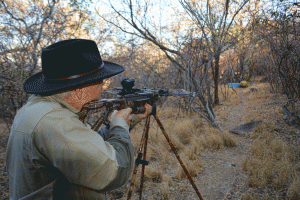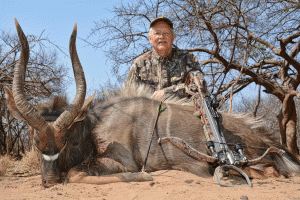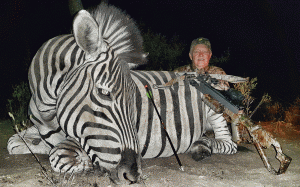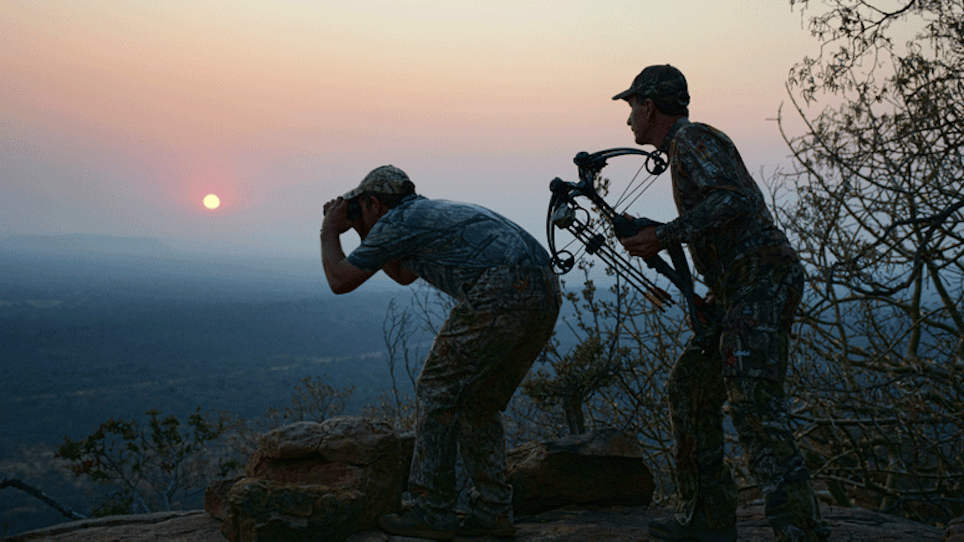What if you knew of a treestand where you’d likely see whitetail deer, elk, mule deer, moose and caribou? “The best stand ever!” you’d say – yet something similar would be just another day in an African waterhole blind.
“On any given day, you may see two dozen species of game,” said Rassie Erasmus as he described his unique concession in the Limpopo Province of South Africa at the Safari Club International Convention.
“Can I use a crossbow?” I asked, trying not to sound too excited about a prospective hunt.
“Absolutely,” he replied. “We always have one or two in camp in case someone’s bow fails or they just want to try a crossbow for variety.”
Needless to say, I booked the safari for mid-August, a period of new moon and a month when dryness should prompt most game animals to drink each day. On August 18th, my crossbow safari began, and the results far exceeded expectations.
Management Safari Options
Erasmus operates a 6,000-acre game ranch five hours north of Johannesburg that has been in his family for six generations. Unlike most hunting concessions in South Africa, this property has a mountain squarely in the middle, and the landscapes feature stark rock outcroppings and giant boulders. In the 1940s, the owners traded leopards for nyala, and the population quickly took hold despite high predator numbers.
 Erasmus offers a management option that can dramatically reduce the cost of a safari and was one of the reasons we booked the hunt. I estimated that my cost for a five-animal package and airfare to and from South Africa would be a little over $5,000 – about the cost of a week in a quality Midwest whitetail camp.
Erasmus offers a management option that can dramatically reduce the cost of a safari and was one of the reasons we booked the hunt. I estimated that my cost for a five-animal package and airfare to and from South Africa would be a little over $5,000 – about the cost of a week in a quality Midwest whitetail camp.
“I post trail cameras at each waterhole and evaluate the health of my herds in October,” Erasmus said. “All of my waterholes are at least a mile apart so that animals often drink at the same ones on a regular basis and I can post hunters depending on what they want to shoot. In this way, hunters get a price break and I help maintain the health of my herds.”
Management animals can include antelope with a broken horn or tip, animals well beyond their breeding stage and, in one case, a zebra from which a rival stallion bit the tail. “That’s a management animal for sure,” laughed Erasmus. “Who wants a rug with no tail?”
A Quest For Kudu
This was my 22nd safari, so I felt confident that I could distinguish management animals from prime trophy species. My first day began in an elevated hide, posting an hour after sunrise as is typical in Africa. Soon, animals began to drink at a natural waterhole directly below the stand. Kudu, nyala and zebra were my primary species of interest, and this stand had frequent visits by all but the striped critters. By 10 a.m. I had seen 50 nyala, more of the antelope than I’d seen in 22 safaris combined. The females sneaked in through dense brush and drank under a cover of thorny vegetation with the solitary males even more reclusive. Their shaggy black coats were barely visible in the dense cover.
 Next, a kudu bull came to drink at the main waterhole, followed by another, and another. Soon, I had six mature bulls within 30 yards, and my management evaluating confidence began to crumble. Probably one of the animals was a management bull, but which one? Normally, I can evaluate horn length well, but suddenly they all looked alike.
Next, a kudu bull came to drink at the main waterhole, followed by another, and another. Soon, I had six mature bulls within 30 yards, and my management evaluating confidence began to crumble. Probably one of the animals was a management bull, but which one? Normally, I can evaluate horn length well, but suddenly they all looked alike.
Within an hour, the bachelor kudu boys returned, and I scoured each one with binoculars and suddenly noticed the white horn tips and age spots. Unfortunately, the management animal chose not to drink, but stood in the shade of a tree for nearly an hour before melting back into the bush. My heart sank as I watched it walk away.
The afternoon passed quickly as one species of animal after another came to the water. Suddenly, a set of tall, curled horns with white tips appeared at the water. “That’s him!” I thought to myself. Glassing the white spots on its head, I sprang into action, switched the safety “off” on the Excalibur Micro 335 and put the red dot from the Aimpoint H-2 low on the shoulder. I squeezed, and the arrow zipped through both shoulders of the beast, causing it to whirl and run. I saw the Boltcutter broadhead protruding from the far shoulder and knew I’d gotten complete penetration on the 600-pound animal. After a 100-yard blood trail, Erasmus extended his hand in congratulations. “That’s the one,” he said with a broad smile.
A Change in Tactics
The second morning we got up well before dawn, had breakfast, and entered the blinds in darkness with the plan of returning for lunch and then sitting a stand until dark. This allowed us to see animals that perhaps came to drink very early or at last light.
Zebra are notorious for showing up at a waterhole in the last second of shooting light, and this ultra-elusive animal was high on my list. Zebra are a “second-safari” animal as most first-time hunters think they are just a “horse with stripes,” yet they are one of the most aware animals you can hunt with a bow. For rifle hunters, shooting one at 300 yards while it stands in the open is no big deal, but just try to slip up on one or even ambush it at a waterhole.
“They rarely drink before dark,” Erasmus advised, “but I have one blind where they often drink. You won’t be able to shoot any other animals and have to be extremely quiet if you want to see them,” he said. “Maybe you’ll get lucky.”
Normally, South Africa in August is cold at night and up to 70 in the afternoon, but this year’s weather was abnormally hot. Climbing into the blind around 1 p.m., the temperature neared 100 degrees. The waterhole was a hub of activity with eland, wildebeest, kudu, impala, nyala and finally … stripes. A small herd of zebra approached to drink with either a big stallion or fat mare about to foal among the herd. I finally had the shot angle I wanted but didn’t want to take a pregnant mare. The animals drank for a minute or two and quickly disappeared. As darkness fell, the zebra with no tail showed as well, but it was too dark to shoot.
Trophy Hunting In Reverse
If you are a fan of TV hunting shows, you know that it’s a popular practice to name a particular target buck or two and hold out for those trophy animals. This management hunt was just the opposite. Each day, I’d see several high-scoring trophy animals, but I was looking for management animals with abnormal horns or aged well past reproduction. As I learned, identification of management animals required a lot of patience and visual analysis.
Professional Hunter Pieter Otto spent the third day with me, and his experience and help was invaluable. Our quest was a management nyala bull, and we seemed to be in a honey hole for that species as one big bull after another came to drink. We easily saw 100 animals, including a management impala and warthog, which we trailed and transported to the meat locker at the end of the day.
Seeking Sage Advice
By the fourth day I had seen dozens of nyala bulls and surely some of them were the management types. Management animals were one-third the price of a prime trophy, and hunting with a guide seemed the best bet. Actually, I doubled up with one of my hunting friends as we each wanted different game animals and the advice of an experienced pair of eyes would be invaluable.
We got an early start in the same blind where I killed the kudu bull and remembered seeing numerous nyala bulls. Around 10 a.m., a dark figure sneaked into the thorn-covered waterhole below the stand and my guide gave me the thumbs up. The nyala bull stepped from the water and passed through a narrow opening. The angle was steep, but the Aimpoint red dot held steady and the arrow zipped through both sides. The beast ran, but lay still in seconds.
In the afternoon, my wife Vel and I returned to try for the zebra trophy one more time. The stand hadn’t been hunted since I passed the stallion the second evening, and I hoped that things had settled enough to get a shot.
As the afternoon wore on, the usual parade of kudu, wildebeest and a herd of nearly 50 impala drank and dawdled around the water. When animals drink and seem relaxed at a waterhole, it sends the message that the coast is clear to more wary species. I took great care to be very still and quiet in the stand.
Suddenly, I saw a large zebra standing off to my right, waiting and watching. Holding my breath, I moved the safety to “off” and got ready. Four smaller animals approached first and came directly to the water with the larger animal, a thick-necked stallion lagging behind. It took several steps closer and was almost broadside, testing my patience. Long moments passed as it took several more steps and presented the angle I needed.
On impact, the zebra turned, but did not run. Awkward on its feet, the animal moved about 30 yards and went down, the rest of the animals standing and watching. The chest of this animal was nearly two feet thick, yet the arrow and Boltcutter broadhead passed completely through.
Gear That Delivered
My safari ended with five animals from five arrows, and I couldn’t have been more pleased with the performance. Here’s a quick look at what worked so well:
Excalibur Micro 335 ($900): With a 270-pound draw weight from recurve limbs, this small, light bow generates excellent arrow speed with a compact package that accounted for a complete pass-through on every animal. At just 5.2 pounds, it’s one of the lightest hunting bows on the market.
Aimpoint H-2 ($780): The compact sight was the perfect match for the Micro and gave instant aiming with no pin confusion. Sighted-in at 20 yards, it was an inch high at 15 yards and an inch low at 25 yards.
Diablo Arrows ($65), Boltcutter Broadheads ($45): At first I was a bit nervous about the shorter, lighter Diablo arrows and the cut-on-contact Interlock 150-grain broadheads. No more. The team got incredible penetration and downed game in seconds.
TriggerTech: The Micro 335 came with a good trigger, but the custom TriggerTech trigger ($130) had zero creep and helped make quick, accurate shots.
ScentBlocker: Scent elimination is just as important with African antelope as for whitetail deer. The Alpha Jackets ($260) with WindBreak technology were quiet and fooled hundreds of noses in front of the blinds.






